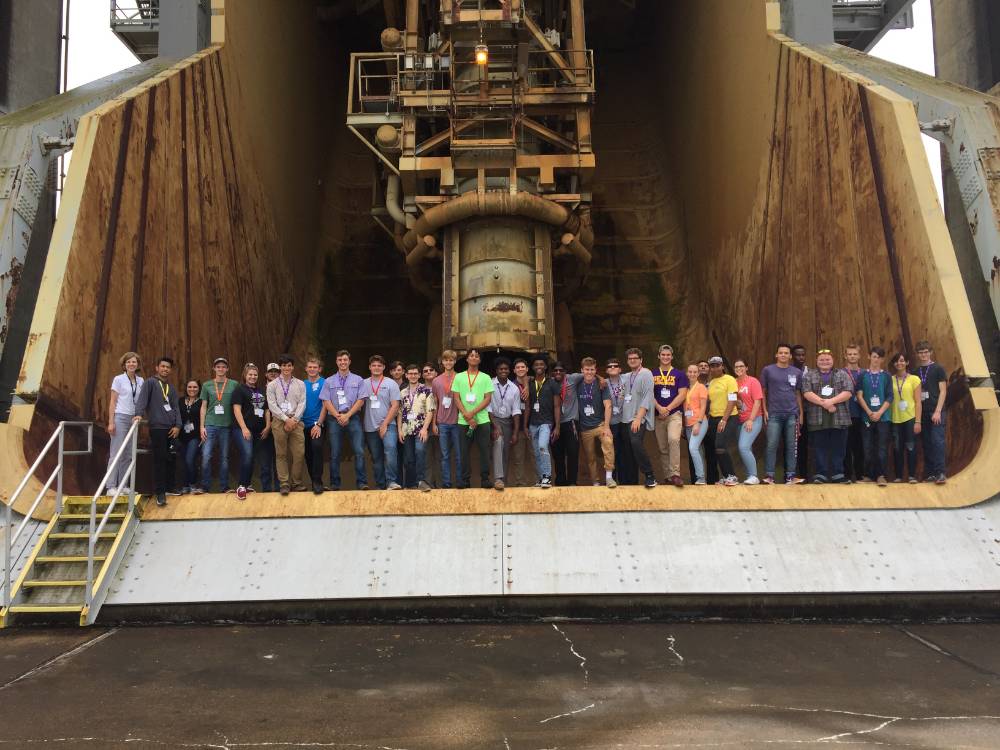E2 Plus Gulf Coast: Program Exposes Students to Real-World Engineering
 BATON ROUGE, LA – For LSU Engineering students, there is no better classroom than
the Gulf Coast.
BATON ROUGE, LA – For LSU Engineering students, there is no better classroom than
the Gulf Coast.
The industrious area is a cornucopia of engineering companies that were recently made accessible to students through the College of Engineering’s Encounter Engineering Plus (E2+) Gulf Coast program. This segment of E2+ not only aimed to show participants what engineering is like in the real world, but also to help them find the field that interests them the most.
For four days in August, LSU Engineering Instructor Paige Davis took 32 incoming LSU Engineering students to tour various companies along the Gulf Coast, a new destination for the E2+ program. Since 2016, the program has allowed students (mainly sophomores and juniors) the opportunity to travel across the country and visit engineering giants such as Google, Amazon, Boeing, Kennedy Space Center, and Microsoft and expand their opportunities for internships, co-ops, networking, and future job searches.
This trip, however, served a different purpose.
“The Gulf Coast program had a different focus,” Davis said. “It was designed for incoming freshmen to introduce them to engineering. The goal was to show them what each of the different engineers actually does so they would have a better understanding and could differentiate between all of the engineering disciplines.”
The idea for the E2+ program branched off of LSU’s Encounter Engineering Bridge Camp (E2), which is run by Assistant Director of Student Programs and Outreach Adrienne Steele each year in Patrick F. Taylor Hall. Students who participate in the E2 camp are given the opportunity to travel on the E2+ trips.
“The idea is we just take E2 a step further,” Davis said. "The Encounter Engineering program is huge here on campus. The E2+ programs are smaller and leave campus. E2+ takes students out of the classroom and into industry so they can see what engineering looks like up close.”
The E2+ Gulf Coast itinerary included an array of activities, from exploring the beaches of Grand Isle to learning about space shuttle propulsion at Stennis Space Center. The first stop, however, was to visit what’s right here in the students’ own backyard—the LSU Center for River Studies.
“We had two tour guides who took the time to talk to us about the river model after the tour,” said Elijah Smith, a freshman in electrical and computer engineering from Baton Rouge. “It was really nice.”
Davis and her group then traveled to Robert, where they spent the second day visiting the Shell Training & Conference Center and learning about offshore training, safety, and simulation.
“This was my favorite part of the trip,” said LSU Mechanical Engineering freshman Nekita Pitts, a native of Zachary, La.. “They’re starting to implement virtual technology into training. When a trainee comes in, they just latch on the virtual headset and they see what the entire plant looks like, so you can manipulate the model itself.”
The students then traveled to Intralox in Hammond to learn about manufacturing and automation, followed by a jaunt to Stennis Space Center in Mississippi, where they checked out the Aerojet Rocketdyne Engine Assembly Facility and NASA’s Propulsion Test Complex.
“Aerojet was really interesting,” Pitts said. “Stennis has 125,000 acres of dead zone and there are different companies on the property who work with NASA.”
To give the students a firsthand look at Louisiana coastal projects, Davis scheduled tours at the LA-1 Bridge outside of Moran’s Marina, Louisiana Offshore Oil Port (LOOP) in Cut Off, and Port Fourchon.
“We toured different areas near Port Fourchon where we learned if we don’t do something about Louisiana’s erosion problem, it’s all going to go away,” Pitts said. “It’s a huge chunk of the coast.”
The last leg of the trip was a tour of Elmer’s Island in Grand Isle, where the students checked out an oil infrastructure and saw how impactful an oil spill could be on an ecosystem by learning about the Caminada Headland Beach and Dune Restoration project.
“We really got to see what’s going on in the Gulf Coast due to the [2010] oil spill,” Smith said. “Oil really got into the sand, so they had to dig up the beach to find it. They also explained to us how difficult jobs are because you can’t build in certain areas to protect bird eggs.”
Overall, the students enjoyed learning about the Gulf Coast and its relation to engineering while meeting other students who have become familiar faces around campus their first year.
“There were a lot of people in the program but I made a few good friends,” Pitts said.
“The program provided a lot of opportunities to learn about engineering,” Smith said. “I’m now in a group chat with other E2+ Gulf Coast students and just visited with my E2 leader before I came here. I’m thinking about joining Society of Peer Mentors so I can become a team leader and go on other trips.”
“E2+ helps students better understand the opportunities that their engineering degree can provide them when they graduate,” Davis said. “My hope is that students will be more excited about their chosen degree, knowing that all the hard work has a purpose.”
Like us on Facebook (@lsuengineering) or follow us on Twitter and Instagram (@lsuengineering).
###
Contact: Libby Haydel
Communications Specialist
225-578-4840